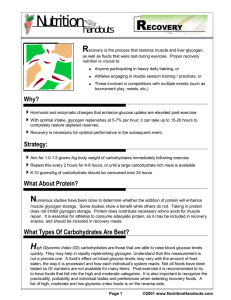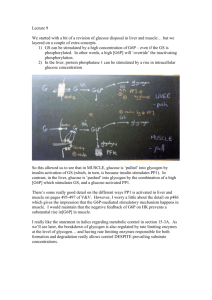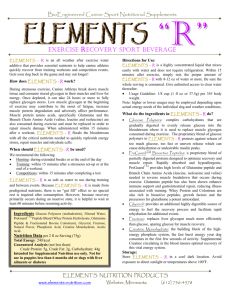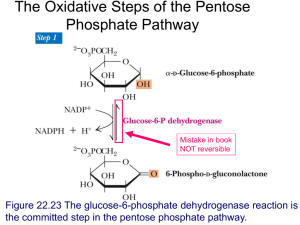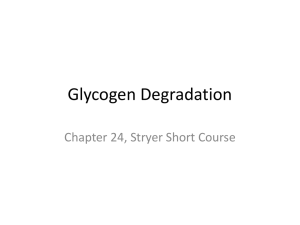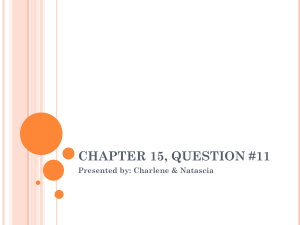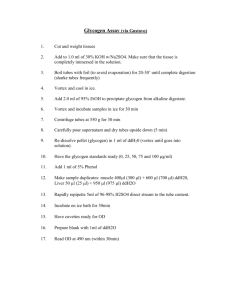Effect of low glycogen on ... metabolism in human muscle during ...
advertisement
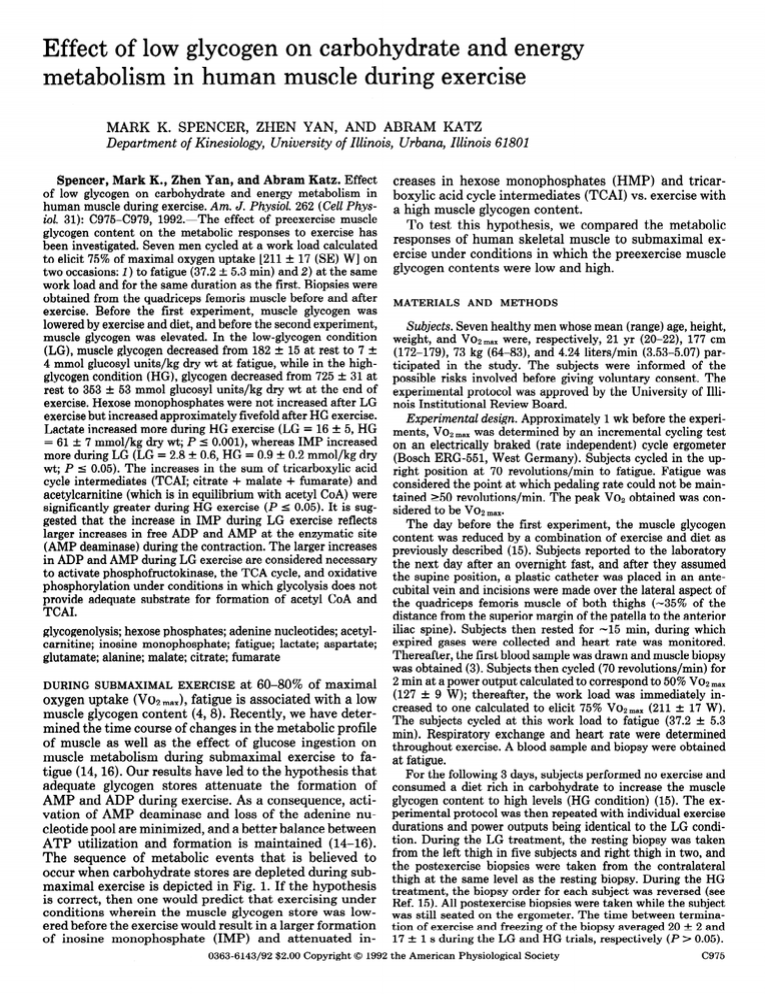
Effect of low glycogen on carbohydrate and energy metabolism in human muscle during exercise MARK K. SPENCER, Department ZHEN of Kinesiology, YAN, University AND ABRAM of Illinois, Spencer, Mark K., Zhen Yan, and Abram Katz. Effect of low glycogen on carbohydrate and energy metabolism in human muscle during exercise. Am. J. Physiol. 262 (Cell Physiol. 31): C975-C979, 1992.-The effect of preexercise muscle glycogen content on the metabolic responses to exercise has been investigated. Seven men cycled at a work load calculated to elicit 75% of maximal oxygen uptake [2ll& 17 (SE) W] on two occasions: 1) to fatigue (37.2 t 5.3 min) and 2) at the same work load and for the same duration as the first. Biopsies were obtained from the quadriceps femoris muscle before and after exercise. Before the first experiment, muscle glycogen was lowered by exercise and diet, and before the second experiment, muscle glycogen was elevated. In the low-glycogen condition (LG), muscle glycogen decreased from 182 ? 15 at rest to 7 & 4 mmol glucosyl units/kg dry wt at fatigue, while in the highglycogen condition (HG), glycogen decreased from 725 & 31 at rest to 353 t 53 mmol glucosyl units/kg dry wt at the end of exercise. Hexose monophosphates were not increased after LG exercise but increased approximately fivefold after HG exercise. Lactate increased more during HG exercise (LG = 16 & 5, HG = 61 k 7 mmol/kg dry wt; P 5 O.OOl), whereas IMP increased more during LG (LG = 2.8 k 0.6, HG = 0.9 & 0.2 mmol/kg dry wt; P 5 0.05). The increases in the sum of tricarboxylic acid cycle intermediates (TCAI; citrate + malate + fumarate) and acetylcarnitine (which is in equilibrium with acetyl CoA) were significantly greater during HG exercise (P 5 0.05). It is suggested that the increase in IMP during LG exercise reflects larger increases in free ADP and AMP at the enzymatic site (AMP deaminase) during the contraction. The larger increases in ADP and AMP during LG exercise are considered necessary to activate phosphofructokinase, the TCA cycle, and oxidative phosphorylation under conditions in which glycolysis does not provide adequate substrate for formation of acetyl CoA and TCAI. glycogenolysis; hexose phosphates; adenine nucleotides; acetylcarnitine; inosine monophosphate; fatigue; lactate; aspartate; glutamate; alanine; malate; citrate; fumarate SUBMAXIMAL EXERCISE at60-80% of maximal oxygen uptake (VO 2max),fatigue is associated with a low muscle glycogen content (4, 8). Recently, we have determined the time course of changes in the metabolic profile of muscle as well as the effect of glucose ingestion on muscle metabolism during submaximal exercise to fatigue (14,16). Our results have led to the hypothesis that adequate glycogen stores attenuate the formation of AMP and ADP during exercise. As a consequence, activation of AMP deaminase and loss of the adenine nucleotide pool are minimized, and a better balance between ATP utilization and formation is maintained (14-16). The sequence of metabolic events that is believed to occur when carbohydrate stores are depleted during submaximal exercise is depicted in Fig. 1. If the hypothesis is correct, then one would predict that exercising under conditions wherein the muscle glycogen store was lowered before the exercise would result in a larger formation of inosine monophosphate (IMP) and attenuated inDURING 0363-6143/92 $2.00 Copyright KATZ Urbana, Illinois 61801 creases in hexose monophosphates (HMP) and tricarboxylic acid cycle intermediates (TCAI) vs. exercise with a high muscle glycogen content. To test this hypothesis, we compared the metabolic responses of human skeletal muscle to submaximal exercise under conditions in which the preexercise muscle glycogen contents were low and high. MATERIALS AND METHODS Subjects. Seven healthy men whose mean (range) age, height, weight, and VO 2maxwere, respectively, 21 yr (20-22), 177 cm (172-179), 73 kg (64-83), and 4.24 liters/min (3.53-5.07) participated in the study. The subjects were informed of the possible risks involved before giving voluntary consent. The experimental protocol was approved by the University of Illinois Institutional Review Board. Experimental design. Approximately 1 wk before the experiments, VOzmaxwas determined by an incremental cycling test on an electrically braked (rate independent) cycle ergometer (Bosch ERG-551, West Germany). Subjects cycled in the upright position at 70 revolutions/min to fatigue. Fatigue was considered the point at which pedaling rate could not be maintained 250 revolutions/min. The peak Vo2 obtained was considered to be Vo2 mBx. The day before the first experiment, the muscle glycogen content was reduced by a combination of exercise and diet as previously described (15). Subjects reported to the laboratory the next day after an overnight fast, and after they assumed the supine position, a plastic catheter was placed in an antecubital vein and incisions were made over the lateral aspect of the quadriceps femoris muscle of both thighs (-35% of the distance from the superior margin of the patella to the anterior iliac spine). Subjects then rested for ~15 min, during which expired gases were collected and heart rate was monitored. Thereafter, the first blood sample was drawn and muscle biopsy was obtained (3). Subjects then cycled (70 revolutions/min) for 2 min at a power output calculated to correspond to 50% Vo2 max (127 t 9 W); thereafter, the work load was immediately increased to one calculated to elicit 75% V02max (211 k 17 W). The subjects cycled at this work load to fatigue (37.2 t 5.3 min). Respiratory exchange and heart rate were determined throughout exercise. A blood sample and biopsy were obtained at fatigue. For the following 3 days, subjects performed no exercise and consumed a diet rich in carbohydrate to increase the muscle glycogen content to high levels (HG condition) (15). The experimental protocol was then repeated with individual exercise durations and power outputs being identical to the LG condition. During the LG treatment, the resting biopsy was taken from the left thigh in five subjects and right thigh in two, and the postexercise biopsies were taken from the contralateral thigh at the same level as the resting biopsy. During the HG treatment, the biopsy order for each subject was reversed (see Ref. 15). All postexercise biopsies were taken while the subject was still seated on the ergometer. The time between termination of exercise and freezing of the biopsy averaged 20 * 2 and 17 t 1 s during the LG and HG trials, respectively (P > 0.05). 0 1992 the American Physiological Society c975 C976 GLYCOGEN AND TRICARBOXYLIC Pyruvate t Decreased 2-Oxoglutarate Decreased Oxaloacetate Decreased Decreased + Fructose Decreased PFK Activity 6-P Decreased Glycolysis I 4 -3 Decreased Acetyl-CoA TCAI Decreased Mitochondrial NADH Production Activation of TCA Cycle and Oxidative Phosphorylation + . Decreased AT Production 4- 1 Increased CYCLE INTERMEDIATES RESULTS Decreased Carbohydrate Decreased ACID ADP 1 Decreased PCr Deaminase Increased IMP + NH2 Fig. 1. Scheme proposing the sequence of metabolic events in muscle during exercise when carbohydrate stores are depleted. See text and Refs. 14 and 16 for further details. Analytical methods. All biopsies were quick frozen (~2 s after excision) in the needle by immersion into liquid Freon and maintained at its melting point (-150°C) with liquid NP. The biopsies were stored in liquid Nz until preparation for analysis, at which time they were lyophilized, dissected free of solid nonmuscle constituents (connective tissue and blood), powdered, and thoroughly mixed. One aliquot of powder was extracted and analyzed for metabolites by enzymatic methods (2, 12) as previously described (16). Reverse-phase high-performance liquid chromatography was used to quantify adenine nucleotides, their catabolites, and NAD’ (17). Except for lactate, pyruvate, and glucose (due to their extracellular presence), muscle metabolites were normalized to the mean total creatine content (sum of phosphocreatine concentration ([PC,]) and creatine concentration ([Cr])) for the whole material (111.9 & 2.5 mmol/kg dry wt) to correct for variability in solid nonmuscle constituents between biopsies. Blood was drawn anaerobically and immediately injected into ice-cold tubes containing EDTA. The samples were left on ice for 10 min and centrifuged at 4”C, and the plasma was aspirated and stored at -80°C until analysis. Plasma was analyzed for insulin by radioimmunoassay (Diagnostics Products, Los Angeles, CA), free fatty acids, glucose, and lactate, as previously described (16). Whole body respiratory exchange was measured by continuous collection of 30-s aliquots of expired air and analyzed for fractional components of 02 and CO2 (Applied Electrochemistry S-3Al and CD-3A, respectively, Sunnyvale, CA). Ventilation was measured with a turbine transducer gas flowmeter (Pneumoscan S-300, Sylmar, CA). Heart rate was monitored by telemetry. Statistics. Significant differences (P < 0.05) between means were determined with Student’s t test for paired observations. Values are reported as means t SE unless otherwise indicated. Cardiorespiratory. Heart rate and VOW increased progressively during exercise, but the increases were attenuated during HG (Table 1). These results are consistent with previous observations (X,16) and are probably due to an increased carbohydrate oxidation (in HG), which results in a greater caloric yield than fat oxidation (per liter O2 consumed). Significant differences between treatments for respiratory exchange and substrate utilization were found at rest and throughout exercise. After 15 min of exercise, the percent VOzrnax was 76.9 t 2.7 during HG and 81.9 t 3.3 during LG. A&s& metabolites. The exercise and diet manipulations yielded the expected differences in the muscle glycogen contents at rest during LG and HG (Table 2) (15). HMPs were higher and net glycogenolysis was more than doubled during HG exercise. Exercise during LG resulted in virtually complete degradation of glycogen. Glycogen was not measurable in the biopsies at fatigue in four subjects, and the highest value in the remaining subjects was only 23 mmol glucosyl units/kg dry wt. Lactate content was approximately fourfold higher after exercise in the HG group. The higher glycogenolytic rate and lactate content in muscle indicate that glycolysis was higher during HG exercise. Glutamate decreased during exercise in similar fashion in both treatments, while aspartate increased approximately threefold during LG but was not changed after HG exercise. Free carnitine decreased and acetylcarnitine increased during exercise under both conditions (Table 3). However, acetylcarnitine was significantly increased in the LG resting condition, which is probably due to increased fat oxidation (7). The increase in acetylcarnitine from rest to end of exercise was significantly higher with HG (13.3 t 0.9 vs. 4.9 t 2.7 mmol/kg dry wt; P 5 0.05). While fumarate and malate were similar at rest, citrate was ~50% higher at rest with LG, which can also be attributed to increased fatty acid oxidation (6). TCAI Table 1. Cardiorespiratory and during variables at rest exercise Duration of Exercise, min Rest Heart rate, beats/min Low glycogen High glycogen VO2, l/min Low glycogen High glycogen RER Low glycogen High glycogen Carbohydrate oxidation, g/min Low glycogen High glycogen Fat oxidation, g/min Low glycogen High glycogen 69k4 64k3 End of exercise 15 17824 171k2 192t3 181*2t 0.30~0.01 0.29t0.01 3.49t0.26 3.27k0.237 3.77t0.21 3.39+0.21$ 0.70~0.03 0.81kO.O3* 0.83t0.01 0.94*0.01$ 0.81t0.01 0.90+0.02t 0.03zk0.01 0.10~0.04’ 1.67kO. 16 3.13k0.367 1.50&O. 15 2.67k0.45t 0.14zk0.01 0.07+0.01t 1.02kO.09 0.31+0.08t 1.23t0.05 0.56+0.10t Values are means t SE from 5 to 7 subjects. RER, exchange ratio (VCO~/VO,). End of exercise was 37.2t5.3 0.05; t P 5 0.01; $ P 5 0.001 vs. low glycogen. respiratory min. * P 5 GLYCOGEN AND TRICARBOXYLIC ACID CYCLE c977 INTERMEDIATES Table 2. Muscle contents of glycogen, glycolytic intermediates, and amino acids Rest Glycogen Glucose Intracellular glucose Glucose- 1 -P Glucose-6-P Fructose-6-P Pyruvate Lactate Alanine Glutamate Aspartate r--*1 Exercise Low glycogen High glycogen Low glycogen High glycogen 182*15 2.1t0.2 0.7OkO.17 725&31* 2.OkO.l 0.34*0.09* 7*4 1.620.2 -0.29kO.34 353+53$ 9.7*1.2$ 6.95*1.17? 0.08tO.03 0.77t0.19 0.19&0.04 0.05~0.01 3.4kl.l 5.2tl.l 15.4kO.7 1.4kO.l 0.07tO.01 0.78kO.05 0.17&0.01 0.1 lt0.02 4.5tl.O 10.0+1.0t 13.6kO.9 1.2t0.2 0.07~0.01 0.49kO.13 0.08t0.02 0.27t0.06 17.Ok6.2 8.7tl.7 3.8kO.3 4.3t0.8 0.24&0.03$ 4.11*0.45$ 0.82&0.09$ 0.4320.06 60.8+6.5$ 14.2kl.57 3.8k0.2 1.5kO.3" Values are means of:SE from 6 or 7 subjects (except glycogen at rest in low glycogen treatment; n = 4) and are given in mmol/kg dry wt, except glycogen which is given in mmol glucosyl units/kg dry wt. Glucose-6-P, glucose-6-phosphate. Intracellular glucose is calculated from total muscle glucose minus extracellular glucose, assuming 0.3 1 of extracellular water/kg dry wt at rest and 0.52 after exercise, and the plasma glucose concentration at the time of biopsy reflects the glucose concentration in the extracellular space (9). * P 5 0.05; t P 5 0.01; $ P 5 0.001 vs. low glycogen. Low Glycogen High Glycogen Fig. 2. Change in the sum of tricarboxylic acid cycle intermediates (TCAI; malate + citrate + fumarate) during exercise (i.e., exercise rest value). Values are means ,t SE for 7 subjects. *:P (: 0.05. Table 4. Muscle contents of high-energy purine nucleotide catabolites, Rest Low glycogen Table 3. Contents of carnitines acid cycle intermediates and tricarboxylic in muscle Rest Total carnitine Carnitine Acetylcarnitine Citrate Exercise Low glycogen High glycogen Low glycogen High glycogen 18.0&l.& 15.2zk2.2 2.8zkO.7 0.49kO.05 0.07t0.01 0.2920.02 18.3kl.4 18.ltl.3 0.2-I-0.q 0.33kO.03" 0.06t0.01 0.24t0.04 15.2kl.2 7.6tl.9 7.7k2.4 0.62kO.09 0.58t0.10 2.11t0.28 16.8kl.2 3.3t0.4 13.5kO.9 0.69kO.09 0.73t0.07 2.5lt0.14 Fumarate Malate Values are means * SE from 7 subjects and are given in mmol/kg dry wt. Total carnitine was calculated from Zcarnitine + acetylcarnitine. * P 5 0.05; t P 5 0.01 vs. low glycogen. (citrate, fumarate, and malate) increased during exercise in both treatments and, although not statistically significant, demonstrated a trend to be higher after exercise with HG. However, when accounting for the higher resting citrate level, the increase in the sum of TCAI during exercise was greater with HG (P 5 0.05) (Fig. 2). The contents of TCAI after LG exercise are similar to those observed after performing a similar exercise bout to fatigue with a normal initial muscle glycogen content (445 mmol glucosyl units/kg dry wt) (14). Exercise during LG resulted in a lower ATP content (Table 4) and higher contents of IMP and xanthine compared with HG, which are consistent with previous findings (13-S). Plasma metabolites. Plasma glucose and insulin concentrations were higher both before and after exercise with HG (Table 5). The decrease in glucose was significantly greater with the LG treatment. Both before and after exercise, the lactate concentration in plasma was greater with the HG treatment. The free fatty acid concentration in plasma was higher before and after exercise during the LG treatment. PCr + creatine PCr ATP ADP AMP IMP Adenosine Inosine Hypoxanthine Xanthine NAD+ 112.8k5.6 78.7k2.9 22.2kl.O 3.2kO.l 0.08~0.01 0.10~0.01 co.01 0.09~0.01 0.08t0.01 0.14*0.03 2.220.1 phosphates, and NAD+ Exercise High glycogen Low glycogen High glycogen 108.5t2.3 116.7t5.7 108.4zk5.7 73.6k2.9 23.5tl.8 20.9t2.5 22.2r40.7 17.9kO.9 20.6&1.1* 3.2kO.l 3.420.1 3.520.1 0.103r0.01 0.14~0.01 0.11+0.02 0.09t0.01 2.82t0.63 0.89t0.20" 0.01~0.00 0.02*0.00 0.02,t0.01 0.12z!zO.O3 0.27zkO.04 0.2OzkO.03 0.06+0.01 0.17t0.03 0.12kO.03 0.11t0.02 0.38t0.06 0.19t0.04' 2.4tO.l 2.0tO.l 2.lkO.l Values are means & SE from 6 or 7 subjects and are given in mmol/ kg dry wt. PCr, phosphocreatine. * P 5 0.05 vs. low glycogen. Table 5. Plasma variables at rest and after exercise Rest Low glycogen Glucose Insulin Lactate Free fatty acids 4.71t0.11 6tl 0.74t0.04 0.80t0.10 Exercise High glycogen Low glycogen High glycogen 5.55+0.11$ 12t3* 0.96t0.07* 0.35+0.05t 3.54t0.30 3tl 5.33t0.80 0.78kO.10 5.22ko.lot 6tl” 8.05kO.50$ 0.25-+0.04$ Values are means & SE from 7 subjects and are given in mM except for insulin which is in pU/ml. * P 5 0.05; t P s 0.01; $ P 5 0.001 vs. low glycogen. DISCUSSION Carbohydrate availability and TCAI. A major finding in this study was that LG attenuated the increase in TCAI during submaximal exercise, which is consistent with the hypothesis presented in Fig. 1. The lower contents of HMP and higher contents of IMP during LG exercise are also consistent with the hypothesis (the low HMP contents necessitate increases in ADP and AMP which will activate phosphofructokinase as well as AMP deaminase). In our previous studies we were not able to C978 GLYCOGEN AND TRICARBOXYLIC detect significant differences in the acetylcarnitine content, which is in near equilibrium with acetyl CoA (5), in muscle between high vs. low carbohydrate conditions during exercise. Therefore, we limited our explanation of the role of glycolysis to producing pyruvate for anaplerosis (via alanine aminotransferase and/or pyruvate carboxylase), thereby providing adequate levels of TCAI for mitochondrial NADH production (14, 16). However, in our previous studies we did not completely deplete the muscle glycogen store as was accomplished in the present study. Based on the current data, we must now also consider that the lower contents of acetyl CoA during LG exercise may have compromised mitochondrial NADH production, thereby triggering the compensatory increases in the free concentrations of ADP and AMP in the immediate vicinity of phosphofructokinase, AMP deaminase, and mitochondrial dehydrogenases during the contraction (see Fig. 1) (14, 16). According to our hypothesis (see the introduction), one would have expected the absolute level of TCAI in muscle to be lower after LG vs. HG exercise. Although this was the case (3.32 t 0.39 after LG vs. 3.93 & 0.16 mmol/kg dry wt after HG exercise), the difference was not statistically significant. It is noteworthy that in a recent study that employed the same experimental design as in the present study, with the exception that the exercise intensity was -95% VOWmaxjalthough we showed the expected differences in HMP and IMP, there was also no significant difference in TCAI between LG and HG after exercise (15). In this situation, however, the exercise can only be sustained for ~5 min, and there is no measurable decrease in glycolysis during LG vs. HG exercise. Consistent with the findings during short-term exercise is the present finding that the postexercise TCAI value after HG exercise was similar to that after LG exercise in those subjects who cycled for the shortest durations. However, the TCAI value after HG exercise was clearly higher than after LG exercise, in those subjects who cycled for the longest durations. Thus in those subjects who cycled for ~40 min (n = 4), the TCAI value after LG exercise was 4.04 t 0.35 vs. 4.00 t 0.28 mmol/ kg dry wt during HG, whereas in those subjects who cycled for >4O min (n = 3), the TCAI value after LG was 2.35 t 0.15 vs. 3.85 $- 0.13 mmol/kg dry wt after HG. This differential response of TCAI to exercise is apparent even though all subjects were virtually glycogen depleted. These data are in agreement with the idea that low levels of TCAI become apparent only during the latter stage of prolonged exercise (14) and that administration of exogenous carbohydrate will attenuate the decrease in TCAI during the latter part of exercise rather than enhance the formation of TCAI during the initial stage of exercise (16). Aspartate and glycogen. It might be argued that the difference in aspartate between LG and HG after exercise may indicate that LG, in addition to accelerating AMP deamination (15), also inhibits the reamination of IMP to AMP (via adenylosuccinate synthase and lyase), possibly because of the higher IMP levels which can inhibit adenylosuccinate synthase (1). Consequently, the lower levels of TCAI after LG exercise mav be due to dimin- ACID CYCLE INTERMEDIATES ished anaplerosis via the purine nucleotide cycle (ll), rather than lower flux through alanine aminotransferase (yielding %oxoglutarate) or pyruvate carboxylase (yielding oxaloacetate) (Fig. 1). However, in a recent study, we showed that administration of exogenous carbohydrate during prolonged submaximal exercise (-70% VOWmax) attenuated the increase in IMP and maintained higher levels of TCAI but did not affect the increase in aspartate (16). Therefore, the suggestion that the high aspartate content in muscle after LG exercise is indicative of an attenuation of IMP reamination and formation of fumarate is not tenable. The significance of the higher aspartate values after LG exercise is not clear, but it may be related to a greater protein utilization when the muscle glycogen content reaches exceedingly low levels (10). We are grateful to Nancy Cain-Adams, Maria Hilbring, Margaret Williams, and Scott Roecker for technical assistance. Address for reprint requests: A. Katz, Dept. of Clinical Physiology, Karolinska Institute, Karolinska Hospital, Box 60500, S-104 01 Stockholm, Sweden. Received 5 April 1991; accepted in final form 29 November 1991. REFERENCES 1. Aragon, J. J., K. Tornheim, M. N. Goodman, and J. M. Lowenstein. Replenishment of citric acid cycle intermediates by the purine nucleotide cycle in rat skeletal muscle. Curr. Top. Cell Regul. 18: 131-149,198l. 2. Bergmeyer, H. U. (Editor). Methods for Enzymatic Analysis. New York: Academic, 1974. 3. Bergstriim, J. Muscle electrolytes in man. Determined by neutron activation analysis on needle biopsy specimens. A study on normal subjects, kidney patients, and patients with chronic diarrhea. Stand, J. Clin. Lab. Invest. 68, Suppl.: l-110, 1962. J., L. Hermansen, E. Hultman, and B. Saltin. 4. Bergstriim, Diet, muscle glycogen and physical performance. Acta Physiol. Stand. 71: 140-150,1967. 5. Bieber, L. L. Carnitine. Annu. Rev. Biochem. 57: 261-283,1988. 6. Garland, P. B., and P. J. Randle. Regulation of glucose uptake by muscle. Effects of alloxan-diabetes, starvation, hypophysectomy and adrenalectomy, and of fatty acids, ketone bodies and pyruvate, on the glycerol output and concentrations of free fatty acids, longchain fatty acyl-coenzyme A, glycerol phosphate and citrate-cycle intermediates 678-687,1964. in rat heart and diaphragm muscles. Biochem. J. 93: 7. Goodman, M. N., M. Berger, and N. B. Ruderman. Glucose metabolism in rat skeletal muscle at rest. Effect of starvation, diabetes, ketone bodies, and free fatty acids. Diabetes 23: 881-888, 1974. 8. Hermansen, L., E. Hultman, and B. Saltin. Muscle glycogen during prolonged severe exercise. Acta Physiol. Stand. 71: 129-139, 1967. 9. Katz, A., K. Sahlin, and S. Broberg. Regulation of glucose utilization in human skeletal muscle during moderate dynamic exercise. Am. J. Physiol. 260 (Endocrinol. Metab. 13): E411-E415, 1991. 10. Lemon, P. W. R., and J. P. Mullin. glycogen levels on protein catabolism Effect of initial muscle during exercise. J. Appl. Physiol. 48: 624-629,198O. 11. Lowenstein, J. M. Ammonia production in muscle and other tissues: the purine nucleotide cycle. Physiol. Rev. 52: 382-414,1972. 12. Lowry, 0. H., and J. V. Passonneau. A Flexible System of Enzymatic Analysis. New York: Academic, 1972. B., E. Jansson, A. Sollevi, and L. Kaijser. Skeletal 13. Norman, muscle nucleotides during submaximal exercise to exhaustion. Clin. Physiol. 14. Sahlin, 7: 503-509, 1987. K., A. Katz, and S. Broberg. Tricarboxylic acid cycle intermediates in human muscle during prolonged exercise. Am. J. Physiol. 259 (Cell Physiol. 28): C834-C841,1990. GLYCOGEN AND TRICARBOXYLIC 15. Spencer, M. K., and A. Katz. Role of glycogen in control of glycolysis and IMP formation in human muscle during exercise. Am. J. Physiol. 260 (Endocrinol. Metab. 13): E859-E864, 1991. 16. Spencer, mentation M. K., 2. Yan, and A. Katz. attenuates IMP accumulation Carbohydrate supple- in human muscle during ACID CYCLE prolonged c979 INTERMEDIATES exercise. Am. J. Physiol. 260 (CeZZ Physiol. 29): C71- C76,1991. 17. Tullson, nucleotide P. C., D. M. Whitlock, and R. L. Terjung. Adenine degradation in slow-twitch red muscle. Am. J. Physiol. 258 (Cell Physiol. 27): C258-C265, 1990.
